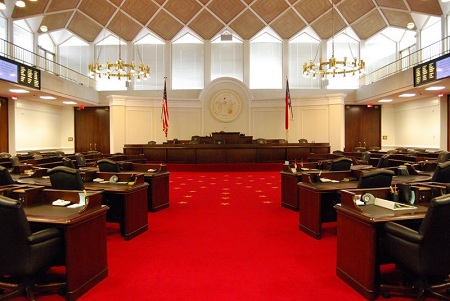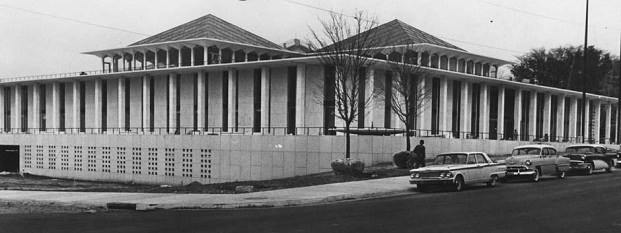
The General Assembly, the lawmaking body of North Carolina, evolved from the colonial legislature established under British rule. That legislature was a bicameral body, with a royal council appointed by the Crown acting as the Upper House and an elected Assembly known as the House of Commons serving as the Lower House. By the end of the colonial period, the Lower House, by controlling the treasury, had become the colony's strongest branch of government.
The North Carolina Constitution of 1776 continued the trend toward a strong legislature and a weak executive. It created a bicameral General Assembly, consisting of a Senate made up of one member from each county and a House of Commons with two members from each county and one from each of several designated towns. Initially only property owners were eligible to serve-House members had to own at least 100 acres and senators at least 300-and the lawmakers were not paid for their services. Early legislative sessions were short, often lasting only a day or two. The governor, who was to be chosen annually by the General Assembly, had no veto power and little control over patronage, nor could he convene, prorogue, or dissolve the Assembly.
Elections to the General Assembly were held annually until the Constitution of 1835, after which they were held every other year except for a brief period of annual elections during Reconstruction. Until the 1835 reforms, the members of the General Assembly were the only state officials elected by popular vote. African Americans were first elected to the Assembly during Reconstruction (1865-77). Henry E. Frye of Guilford County became the first black legislator in modern times when voters sent him to the North Carolina House of Representatives in 1969. After the Twentieth Amendment to the U.S. Constitution passed in 1920, Lillian Exum Clement of Buncombe County in 1921 became the first woman to serve in the North Carolina House of Representatives.
From time to time changes in the state constitution altered the powers and structure of the General Assembly. The sweeping reforms of 1835 provided for the popular election of governors for two-year terms. The 1868 constitution changed the name of the House of Commons to the House of Representatives and created the office of lieutenant governor. The lieutenant governor serves as president of the Senate, standing first in line of succession if the governor dies or becomes incapacitated.
Citizens in western North Carolina resented the early pattern of representation, which, because it was based on the number of counties rather than population, gave control of the General Assembly to the eastern counties. The problem was addressed in the Constitution of 1835, which allotted 50 members to the Senate and 120 to the House. (The number of members remained the same in 2006.) Senators were to be elected from districts based on population. House members were still elected from counties, with each county having at least one representative and the remaining seats parceled out among the more populous counties.
By the early 1960s, urban areas were grossly underrepresented in the General Assembly. In 1963, for instance, the 12 most populous counties had between them 36 House seats representing 1.7 million people, while the 12 least populous held 18 seats representing fewer than 85,000 people. Urban areas were similarly underrepresented by the Senate districts. Under pressure from federal courts, the 1966 General Assembly reapportioned the House and Senate districts. House members were elected from "county districts," which created districts of roughly equal population by combining less populous counties. Senate districts were also reorganized for a fairer distribution of population. Urban districts gained many seats in the legislature at the expense of rural areas.
The General Assembly met in several towns (including Halifax, Hillsborough, New Bern, Fayetteville, Smithfield, and Tarboro) until a permanent capital was established at Raleigh in time for the 1794-95 session. After the original 1796 capitol burned in 1831, the legislature held at least some of its sessions in the governor's "palace" until the current capitol was completed in 1840. By the 1950s the capitol could no longer provide adequate space for legislative sessions, committee meetings, and offices. In 1959 the General Assembly appropriated funds for a new building on Jones Street near the capitol. On 6 Feb. 1963 the lawmakers held their first session in the new Legislative Building. At this time members of both houses, no longer limited by a lack of space, began employing larger professional administrative staffs.

Legislative sessions generally began in November of odd years until 1875, when the opening day shifted to the first Wednesday after the first Monday in January after an election. From 1957 to 1967 sessions were convened in February, but since 1967 they have begun in January. A 1989 law specifies that the General Assembly convenes at noon on "the third Wednesday after the second Monday in January after the election." From the eighteenth century until well into the twentieth, the "long" sessions held in odd years generally lasted from one to three months, depending on the amount of business pending. In recent years, sessions have lasted for six or seven months. The General Assembly now also holds a "short session" in even-numbered years to adjust the budget and deal with other necessary matters.
All lobbyists, and the "principals" that they represent, must register and maintain a strict record of the expenses and transactions related to their role. Lobbyist registration and regulation is controlled by the Department of the Secretary of State. In 2005 the fee to register as an official lobbyist in North Carolina was $200.